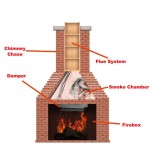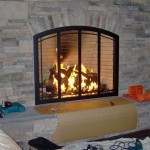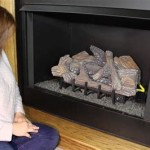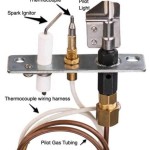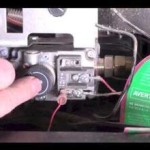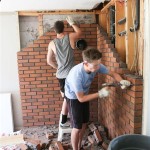Fireplace Flue Damper: Open or Closed? A Comprehensive Guide
The fireplace flue damper, a seemingly simple component, plays a crucial role in the safe and efficient operation of a wood-burning fireplace. Understanding when to keep it open and when to keep it closed is paramount for preventing safety hazards, minimizing energy loss, and maintaining a comfortable home environment. This article provides a comprehensive guide to the functionality of the flue damper and the proper procedures for its use.
A fireplace flue damper is a metal plate located within the chimney flue, typically just above the firebox. Its primary function is to regulate airflow through the chimney. When open, it allows smoke and combustion gases to exit the house. When closed, it seals the fireplace from the elements, preventing drafts and heat loss during periods of non-use. There are primarily two types of dampers: throat dampers and top-mounted dampers. Throat dampers are located directly above the firebox and are typically operated by a lever or handle. Top-mounted dampers are located at the top of the chimney and offer a tighter seal, often featuring a longer lifespan.
Key Point 1: The Importance of an Open Damper During Fireplace Use
The primary and most critical rule regarding flue dampers is that they must be fully open whenever a fire is burning in the fireplace. Failure to do so poses a significant risk of carbon monoxide poisoning. Carbon monoxide is a colorless, odorless gas produced by the incomplete combustion of fuels, including wood. When the damper is closed, the smoke and gases, including carbon monoxide, cannot escape through the chimney. Instead, they are forced back into the living space, rapidly increasing carbon monoxide levels to potentially lethal concentrations.
Carbon monoxide poisoning can occur quickly, with symptoms ranging from headache and dizziness to nausea, confusion, loss of consciousness, and ultimately, death. It is crucial to install and maintain working carbon monoxide detectors throughout the home, particularly near sleeping areas. These detectors will provide an early warning of dangerous carbon monoxide levels, allowing occupants to evacuate and seek medical attention.
Beyond the immediate danger of carbon monoxide poisoning, a closed damper during a fire also creates a significant fire hazard. The smoke and gases trapped within the chimney can cause a buildup of creosote, a highly flammable substance that originates from unburned wood particles. Creosote accumulates on the interior walls of the chimney over time. A chimney fire occurs when this creosote ignites, creating intense heat and potentially spreading flames to the roof or surrounding structure of the house. Keeping the damper fully open ensures proper ventilation and reduces the rate of creosote buildup.
Before lighting a fire, it is imperative to visually inspect the damper to ensure that it is fully open. If the damper is stuck or difficult to open, it should not be forced. Attempting to force a stuck damper could damage the mechanism, exacerbating the problem. Instead, a qualified chimney sweep should be contacted to inspect and repair the damper. They can also clear any obstructions that may be preventing the damper from opening properly.
Furthermore, ensure that there are no flammable materials near the fireplace opening when the damper is open and a fire is burning. Curtains, rugs, furniture, and other combustible items should be kept a safe distance from the firebox to prevent accidental ignition. Embers or sparks can easily escape from the fireplace, especially if the fireplace screen is damaged or missing. Regular inspection and maintenance of the fireplace screen are essential for preventing fires.
Key Point 2: The Benefits of a Closed Damper When the Fireplace is Not in Use
When the fireplace is not in use, the flue damper should be kept tightly closed. An open damper acts as a direct pathway for heat to escape the home and for cold air to enter. This constant airflow can significantly increase heating and cooling costs, particularly during the winter and summer months. The effect is similar to leaving a window slightly open, allowing conditioned air to escape and unconditioned air to enter the home.
The chimney also acts as a conduit for drafts, bringing cold air into the living space. This can lead to uncomfortable temperature fluctuations within the house, making it difficult to maintain a consistent and comfortable environment. A closed damper effectively seals off the fireplace opening, preventing these drafts and maintaining a more stable indoor temperature.
In addition to heat loss and drafts, an open damper can also allow pests and debris to enter the home. Small animals, such as birds, squirrels, and insects, can easily enter the chimney through the open flue. These unwanted guests can create nests within the chimney, causing blockages and potential fire hazards. Debris, such as leaves, twigs, and dirt, can also accumulate in the chimney, further obstructing airflow and increasing the risk of chimney fires. A closed damper prevents these intrusions, maintaining a cleaner and safer chimney.
Top-mounted dampers are particularly effective at preventing heat loss and pest intrusion. These dampers create a tighter seal than traditional throat dampers, providing superior insulation and protection. They are also less susceptible to damage and wear, making them a more durable and longer-lasting option. While they may be more expensive to install initially, they offer significant long-term benefits in terms of energy savings and reduced maintenance costs.
Before closing the damper after a fire, it is essential to ensure that the fire is completely extinguished and that all embers have cooled. Closing the damper prematurely can trap smoke and gases within the house, posing a carbon monoxide hazard. It is advisable to wait at least 12 hours after the fire has burned out before closing the damper. Even after the fire appears to be extinguished, embers can smolder for several hours, releasing carbon monoxide into the surrounding air.
Key Point 3: Maintaining the Damper and Chimney for Optimal Performance
Regular maintenance of the flue damper and chimney is crucial for ensuring safe and efficient fireplace operation. A dirty or damaged damper can compromise its ability to seal properly, leading to heat loss and potential safety hazards. Creosote buildup in the chimney can also significantly increase the risk of chimney fires. Therefore, annual chimney inspections and cleanings are highly recommended.
A qualified chimney sweep can inspect the chimney and damper for any signs of damage or deterioration. They can also remove creosote buildup, ensuring proper airflow and reducing the risk of chimney fires. During the inspection, the chimney sweep will also check the damper mechanism to ensure that it is functioning correctly. If any repairs are needed, they can perform the necessary work to restore the damper to its optimal condition.
When cleaning the chimney, the chimney sweep will typically use specialized tools and equipment to remove creosote and debris from the interior walls of the chimney. They may also use a vacuum to remove loose particles and prevent them from entering the living space. The cleaning process should be performed by a professional to ensure that it is done safely and effectively.
In addition to annual inspections and cleanings, homeowners can also perform some basic maintenance tasks to help keep the damper and chimney in good condition. This includes periodically checking the damper for any signs of damage or corrosion. If the damper is difficult to open or close, it may need to be lubricated. A suitable lubricant, such as graphite powder, can be applied to the damper mechanism to improve its operation. Avoid using oil-based lubricants, as they can attract dust and debris, which can further impair the damper's function.
Also, it's crucial to ensure proper ventilation in the room where the fireplace is located. This helps ensure adequate airflow and combustion. Consider opening a window slightly to provide fresh air, especially when using the fireplace for extended periods. This is a particularly important safety measure in tightly sealed homes to prevent the depletion of oxygen and minimize the risk of carbon monoxide buildup. Regularly checking carbon monoxide detectors remains a critical safety practice.
By understanding the function of the flue damper and following these guidelines, homeowners can safely and efficiently enjoy the benefits of a wood-burning fireplace while minimizing the risks associated with its use. Proper maintenance and adherence to safety precautions are essential for ensuring a comfortable and secure home environment.

How To Open A Chimney Damper Traditional Fireplace Pros

How To Open A Chimney Damper Traditional Fireplace Pros

How To Stop Fireplace Drafts Full Service Chimney

How To Use A Fireplace Damper The Right Way

How Do Fireplace Dampers Work Zoro Com

What S The Purpose Of A Chimney Damper Where Is It Located

What Is A Chimney Damper Full Service

How To Open Your Chimney Damper And Tell If It S Or Closed Priddy Solutions

Basic Home Improvements How Do You Open A Fireplace Damper

The Purpose Of Your Chimney Damper Asheville Nc Environmental
Related Posts

